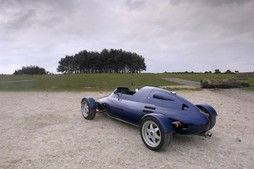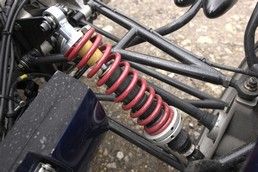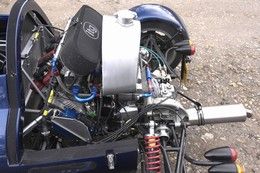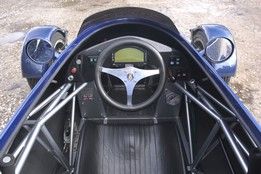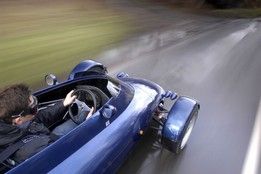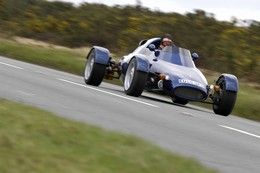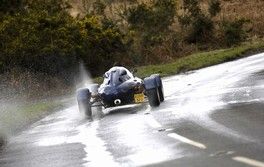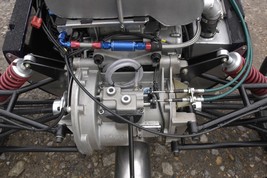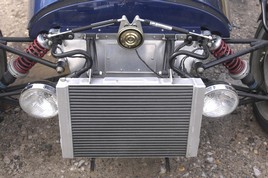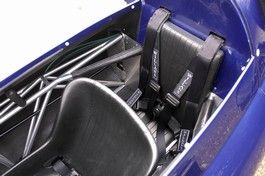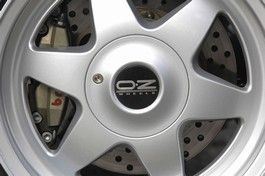ROCKET RELAUNCHES!
James Mills steps up to the launch pad and goes for a drive
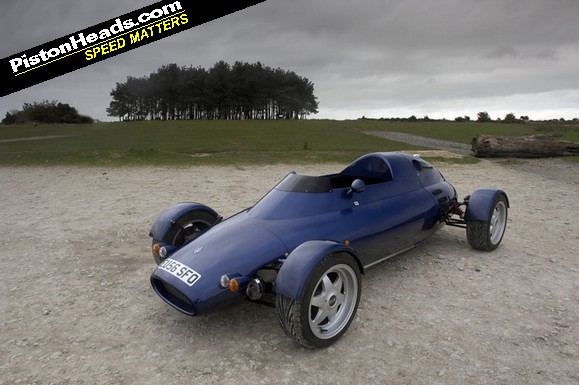
That means there are forty people out there already acquainted with the single-mindedness of two mens’ collective vision on what a light weight sports car should be. That’s how many were sold during the Light Car Company’s first two attempts to survive out in the big wide world.
LCC was the brainchild of ex-Grand Prix racing driver Chris Craft, and his pal Gordon Murray. Yes, the same bloke who masterminded two world championships for Brabham and four for McLaren - in the Senna and Prost heyday.
Oh, and he also designed a road car. You may have heard of it: the McLaren F1. But which came first - the Rocket or the F1? Well, actually, it was the Rocket. And like the widely publicised F1, the Rocket was a bespoke, clean-sheet design that sought to ritually burn every rule book in existence.
Which meant it came at a price - cool £38,800 in fact. And that was back in 1992. “I don’t think they made a penny on any they sold. In fact, I think they lost about £4,000 for every one they sold.” Enter one Luke Craft, son of Chris, and the man tasked with ensuring the Rocket’s third attempt at lift-off goes according to flight plan. He and his father make up Rocket R&D, the company behind the Light Car Company Rocket. He’s been very busy, and would like some of you to buy into the fruits of his labour.
Not too many, mind you. “We’re looking to sell around 10 to 15 a year - not many more, as it takes so long to build the thing!” says Luke, making light of the fact that precious little is off-the-shelf. “The original car was pretty much designed on the drawing board and sold from there,” he continues, and “there just wasn’t enough time allowed for fine tuning. I got my hands on the original demonstrator from my father and went through it, identifying what needed updating.”
To the casual onlooker, it’s an interesting tale of obsession. The double wishbone, coil-over suspension came in for a stiffer anti-roll bar at the back, “too much high speed movement” as Luke tactfully puts it; stiffer bushes all round, bespoke tuning for the Bilstein dampers and wider wheels – OZ alloys wider by half an inch at the front and an inch wider at the back where more of the weight sits.
He didn’t leave it there, though. Or rather, he couldn’t leave it there. The dreaded SVA (Single Vehicle Approval) scheme called for the engineering of a collapsible steering column, a handbrake that actually worked, a bespoke airbox to help the car pass through static noise and emissions tests, baffles in the exhaust and finally fuel injection for the 143bhp Yamaha FZR bike engine.
The latter has come in for a fair bit of fettling in our test car. It boasts an extra 150cc – up to 1,150cc – a larger radiator, high lift cams, high strength valve springs, a ported and polished head and lower friction liners. The result is a healthy 171bhp and an eye-brow raising 86lb/ft of torque at 11,000 and 9,000rpm respectively.
However, it’s when you consider the Rocket weighs three hundred and seventy kilos that the power to weight ratio begins to look stellar. You read that right: three, hundred, and, seventy, kilos.
So, we’ve been wowed by the painfully fastidious craftsmanship, now it’s time to climb aboard. Oh, and change shoes, put on waterproof jacket, insert earplugs, add sunglasses/flying hat and goggles/helmet (your choice), place a cloth on the seat, then climb in, adjust seat and Willans belts, fasten yourself in for the ride of your life, dip the clutch and fire her up. Only then will you realise you haven’t put the Hella headlamps up, and on a grey day such as this one, you really ought to. So it’s back out, flip up the carbon-shrouded headlamps - held in place by natty little Eibach damper arms - and repeat the whole process.
Then you’ll stall, I guarantee it. With no flywheel effect, the Yamaha’s revs rise and fall like a very large, very angry, methanol-powered grass strimmer, and the clutch bites with all the subtlety of stepping onto a live rail.
But I like all that, and I think you will too. The Rocket is an experience, not an appliance. This isn’t about popping to the shops: it’s about a carefully planned weekend excursion or a hardcore trackday.
Get to grips with the clutch (let the car start rolling then catch it with the throttle) and you can start to learn the art of the gearbox. It’s a fully stressed, six-speed sequential transaxle unit of a bespoke design by Weismann (ten F1 championship winning cars to its credit) for the Rocket, with an additional low and high range and a reverse gear. Well, five to be accurate, but I wasn’t about to give it a try…
Tug the lever back for first, get underway and the Rocket begins to overwhelm your senses. The throttle is millimetre-perfect, so you have to tread carefully for fear of kangarooing like a drunkard. Nudge the solid little stub of aluminium forwards and you go up through the ‘box to sixth. Tug back down and you eventually find the long first again – but without any sort of display, even on our car’s optional and worthwhile digital dash, it’s hard to keep track of them.
For the first few hours of driving, there are the inevitable comedy moments where you go to change up only to bang down a gear by mistake. But as it takes a similar amount of time to build confidence to nail the Yamaha engine and set all dashboard lights blinking away in your field of vision, that’s not the disaster it might be.
Toying with up to 7,000rpm, it feels fast, but not that fast. Nevertheless, until we’ve escaped the clutches of Rocket R&D’s east London location and headed for the south coast, I’m not in the mood to give it everything - especially with the damp roads.
My first encounter with the red line arrives heading away from the M2/M25 roundabout, towards the M25 and south. Leaving from the head of the queue, I shift up into second and explore the full reach of the Rocket’s (sensibly) long throttle travel. Only, I’ve forgotten I’m in low ratio for the stop-start traffic, which means all hell breaks loose and as I shift up at around 10,500rpm the tail snaps sideways. For a moment, it’s the Rocket and I, facing Armco, gut-wrenching phone call ringing in my ears. Off the gas, corrective steering, one huge expletive screamed and we gather it up, but it’s a proper ‘moment’.
Gradually though, you and the Rocket begin to click. You become well drilled to stopping, selecting the low ratio, moving away without stalling then nudging back into high ratio, depending on your surroundings. But even by the end of three days of driving, you can never, ever, fully acclimatise to the performance, or the noise.
With low ratio engaged, it is so visceral, so eye-wateringly rapid beyond 8,000rpm that you keep questioning how it can possibly be road legal. Each lightning-fast upshift winds you in the pit of the stomach. 0-60mph comes and goes in around 4.0 seconds. 100mph is gone in 9seconds. With its sequential action and optional ultra-close ratios, there’s no discernable rev-drop or let-up between shifts. Just more speed. More horizon rushing past the well cocooned cockpit. More piercing scream from the most vocal engine note your ear drums will have ever have been savaged by.
Confidence has returned with experience. On tighter roads, the fingertip-light steering, grippy chassis and Porsche 911-esque handling start to make sense. You can take liberties, pile into a second gear bend, lift-off to unsettle the weight balance then gas it to capitalise on the broken grip. And it doesn’t bite you. Cue one very large grin.
But at higher speeds, the Rocket is unnerving. There’s no question, it’s hugely rapid point to point. And with such vast cross-drilled, ventilated discs at both ends and oversized Formula 3 spec’ AP callipers, it’ll haul up in the time it takes to say Light Car Company Rocket. But the thing is so light, so flighty, that you never fully trust the front end. Remember, it’s a good 130kg lighter than a Caterham Seven Superlight, and 100kg lighter than a road spec’ Ariel Atom.
The light steering, kick-back over mid-bend bumps and occasional sniffing around changing cambers and grooved surfaces keeps you on tenterhooks. That and the crosswinds, which can catch it out, plus the fact that the steering, at 2.4 turns lock to lock, isn’t really as direct as it could – and should - be. It’s not cheap either. The entry level 143bhp Rocket retails at £46,412. This 171bhp version, with all its bits n’ pieces, is £53,697.
Yet in super car terms, for the experience, the engineering purity and bespoke specification, it’s a steal. Small wonder Luke Craft has already sold five before the first reviews have even appeared.
It really does transport you to another world. Well, it is a Rocket…
15 Years later and the price has not gone up too much. It is expensive, but very tempting. Not much else that single seater like on the public road.
Gassing Station | General Gassing | Top of Page | What's New | My Stuff

